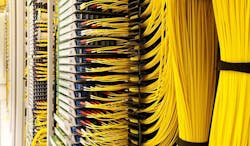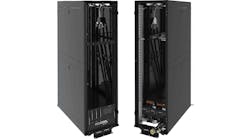Equinix wants to increase the speed and breadth of its connected ecosystems. And after years of focusing on core network hubs in business districts, the company is extending its reach across the full spectrum of the data center business.
Equinix outlined an ambitious agenda for growth in its recent Analyst Day, outlining how its repositioning as “the digital infrastructure company” will translate into a strategy for a world of blended IT platforms.
“Our vision is delivering physical infrastructure at software speed,” said Sara Baack, Chief Product Officer for Equinix. “We see a future where customers can deploy in minutes, on demand, anywhere in the world from an ecosystem of providers. That’s the future we are building for.”
That’s a significant journey from the “power, pipes and ping” formula that once defined the colocation business. Although Equinix is already huge, with 10,000 customers and 229 data centers across the globe, it sees a massive opportunity in the accelerating shift to a digital economy.
Equinix wants to “cloudify” the colocation experience by adding programmable infrastructure running atop the business ecosystems in its data centers, enabling customers to blend physical and virtual assets across technologies and geographies.
“The nature of digital infrastructure is changing,” said CEO Charles Meyers. “Make no mistake about it – it’s more distributed, it’s more on-demand, and it’s more ecosystem-connected than ever before. Cloud computing has forever reshaped the expectations of customers. Equinix has been responding by evolving our abilities.”
Busting Boundaries to Connect Customers
The evolution of Equinix will gain speed in the near future, and has implications for providers across the entire spectrum of data center, cloud and network services.
With its emphasis on digital infrastructure, Equinix is seeking to move beyond traditional product-based understandings of data center services. That includes erasing the once-bright borders between selling space and offering services, a practice embraced by many colocation providers to avoid competing with customers.
Equinix is forging an identity that encompasses a broader range of offerings, including hyperscale data centers, edge computing, bare metal servers and software-defined connectivity.
Equinix is hardly the only colocation provider focused on hybrid cloud and agile infrastructure. Cyxtera was an early player in combining colo with bare metal “one-demand” servers, Flexential and TierPoint offer managed services, and Evoque has recently pushed into cloud-focused consulting. Meanwhile, Digital Realty is pursuing a platform approach that spans wholesale and retail colocation, and software-powered networking specialists Megaport and Packet Fabric ctontinue to bring SDN into more data centers.
The power of Equinix’s vision for digital infrastructure will be tested in its ability to integrate all these approaches as it seeks to extend its market leadership. The overriding narrative is the Equinix approach to building connected ecosystems, which has carried it to 73 consecutive quarters of growth.
“Interconnection is core to our value proposition and story, and our fabric is the best way to connect to a whole ecosystem of customers,” said Jon Lin, President, Americas at Equinix. “That’s the hardest part for our competitors to replicate. It’s not hard to create a software defined network between data centers. But we have 20 years of customer relationships. We’re finding more customers that are magnetic to others, and companies want the ability to connect to them.”
“Network effects bring competitive advantages,” said Steve Madden, VP for Digital Transformation and Segmentation Marketing at Equinix. “Digital ecosystems create density. It’s physics, but it’s not rocket science. Equinix is the shortest distance to the most participants. Clearly the value is significantly amplified if the people and ecosystems you need to do business with are already there.”
A slide from Equinix Analyst Day outlining the company’s customer concentration in leading business verticals. (Image: Equinix)
To help customers make those connections, Madden says Equinix has built a “significant data science operation” to identify cost-productive interconnection benefits for individual customers based on industry patterns and partners.
For Equinix, It’s All About the Ecosystem
That ecosystem focus can be seen in how Equinix is approaching the expansions of its business strategy.
Hyperscale
A good example is xScale, its program to build large data centers for hyperscale providers. After a modest start, Equinix just announced plans to build 32 more hyperscale data centers in key markets around the world, backed by an additional $3.9 billion from GIC, the sovereign wealth fund from Singapore.
That’s not because it aspires to rule the world of hyperscale build-to-suit data center development, a highly-competitive sector that has seen a huge influx of investment.
“We see xScale as a means to an end,” said Krupal Raval, Managing Director for xScale at Equinix. “Its attraction to us is not in isolation, but as a tool in advancing our relationships with hyperscalers, which we believe will maintain and extend our interconnection leadership position in the cloud ecosystem.”
Adding hyperscale data centers at Equinix campuses in key interconnection hubs brings more data gravity to those campuses, making them a magnet for enterprise hybrid cloud deployments requiring low-latency cloud on-ramps. That approach has helped Equinix lease 109 megawatts (MWs) of the of 172 MWs it has built through xScale.
Edge Computing
Equinix has historically focused on the core of the Internet, building clusters of data centers around major network intersections like Northern Virginia, Silicon Valley, Chicago and Dallas. It has begun building out into smaller cities, particularly in international markets.
An aisle inside an Equinix edge data center design, which uses pre-fabricated modules. (Image: Equinix)
The company has recently added a new data center design for edge computing, which can extend low-latency networks closer to users. The new design uses factory-built modules to add capacity in smaller increments.
The edge design is being deployed for the first time in a new facility in Bordeaux, France, which enables Equinix to provide interconnection services at cable landing stations as subsea cable routes diversify to new destinations.
“You’ll see us extend our platform,” said Equinix Chief Financial Officer Keith Taylor. “We’re going to look for those places where there are cable landing opportunities, service aggregation nodes, network nodes.”
Bare Metal Servers
Equinix Metal aims to bring cloud-style automation to physical infrastructure, enabling dedicated servers to be provisioned “as a service.” The bare metal server offering comes integrated with virtual networking technology to quickly connect users with essential clouds and services.
“Equinix Metal fills a market gap between colocation and cloud,” said Zac Smith, Managing Director for Equinix Metal. “What you’re seeing in our product roadmap is an evolution to deliver our traditional core values – global reach, interconnection, ecosystems and trusted support models – for digital consumption behaviors that are changing the way that enterprises and digital service providers compete.”
Metal is also now also offering storage capabilities.
Online Self-Service for Connected Cabinets
Metal is one part of the Equinix effort to “cloudify” its services. Another is Network Edge, its product to provide enterprises with ready access to its SDN fabric and use virtual network functions (VNFs) to manage and extend their network infrastructure.
Programmability is a key innovation theme at Equinix, especially the ability to “make business composable” by orchestrating services through APIs (application programming interfaces).The effort is gaining traction, as Equinix says its API-enabled transaction grew at a 34 percent annual growth rate through the first quarter of 2021.
The goal is to shift more sales to match what users experience on cloud platforms.
“Customers want self-service options,” said Bill Long, Senior VP for Core Product Management. “We believe that as more global business becomes digitally enabled, these capabilities will become more important, and be the cornerstone of our product strategy on an ongoing basis.”
That includes making its core colocation services easier to order. At Analyst Day, Long unveiled plans for Secure Cabinet Express, an offering that will make the most common cabinet configurations available for online ordering, pre-wired for using the Equinix Fabric and ready for customer equipment. Secure Cabinet Express will feature a cabinet with a pre-wired patch panel for fabric and cross-connect ports, with a software-controlled power circuit.
“Our customer gets to buy in an online experience, which is the way they like it,” said Long. “And because we can pre-deploy that equipment, it can be available much faster for our customer. The good part for Equinix is that because we’re pre-deploying it, the amount of OpEx (operating expense) per deployment is much lower for Equinix.”
Bridging the Physical and Virtual Worlds
It’s an ambitious strategy for a fast-changing world. In its presentations to the analyst community, the unifying theme for Equinix is its conviction that the competitive landscape of business will be defined by digital infrastructure, and the future of infrastructure will be developer-led and software-defined.
A slide from the Equinix Analyst Day presentation outlines the company’s growing capability to span physical and virtual infrastructure. (Image: Equinix)
“Our customers want the best of both worlds – both the physical and the virtual,” said Baack. “Equinix is where these come together. Our innovation focus is to make sure that Equinix is the best place to deploy these hybrid clouds. The pandemic has only accelerated customer appetites to consume in this way.”
Expect to see Equinix in more places, as it continues to deploy new capacity to support the “land and expand” pattern that defines the growth strategies for Equinix customers. The number of customers using all three of the company’s geographic regions – North Americas, EMEA and Asia – has grown 37 percent since 2018, with recurring revenue up 62 percent.
“The sun is quickly setting on the days of the centralized data center,” said CEO Meyers. “The action is at the digital edge, and Equinix is the best manifestation of the digital edge, now and for many years to come.”






